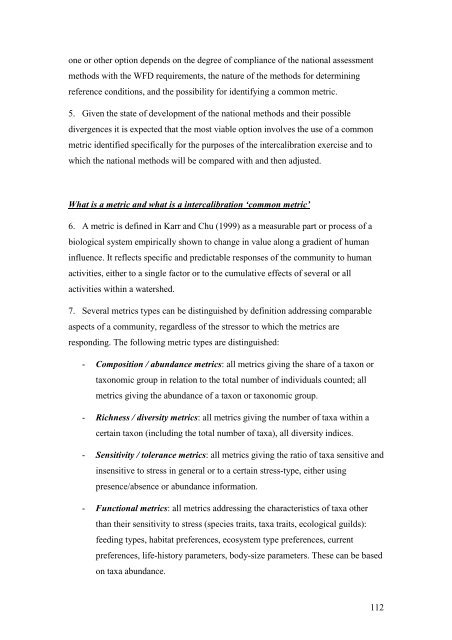Report on Harmonisation of freshwater biological methods
Report on Harmonisation of freshwater biological methods
Report on Harmonisation of freshwater biological methods
Create successful ePaper yourself
Turn your PDF publications into a flip-book with our unique Google optimized e-Paper software.
<strong>on</strong>e or other opti<strong>on</strong> depends <strong>on</strong> the degree <strong>of</strong> compliance <strong>of</strong> the nati<strong>on</strong>al assessment<strong>methods</strong> with the WFD requirements, the nature <strong>of</strong> the <strong>methods</strong> for determiningreference c<strong>on</strong>diti<strong>on</strong>s, and the possibility for identifying a comm<strong>on</strong> metric.5. Given the state <strong>of</strong> development <strong>of</strong> the nati<strong>on</strong>al <strong>methods</strong> and their possibledivergences it is expected that the most viable opti<strong>on</strong> involves the use <strong>of</strong> a comm<strong>on</strong>metric identified specifically for the purposes <strong>of</strong> the intercalibrati<strong>on</strong> exercise and towhich the nati<strong>on</strong>al <strong>methods</strong> will be compared with and then adjusted.What is a metric and what is a intercalibrati<strong>on</strong> ‘comm<strong>on</strong> metric’6. A metric is defined in Karr and Chu (1999) as a measurable part or process <strong>of</strong> a<strong>biological</strong> system empirically shown to change in value al<strong>on</strong>g a gradient <strong>of</strong> humaninfluence. It reflects specific and predictable resp<strong>on</strong>ses <strong>of</strong> the community to humanactivities, either to a single factor or to the cumulative effects <strong>of</strong> several or allactivities within a watershed.7. Several metrics types can be distinguished by definiti<strong>on</strong> addressing comparableaspects <strong>of</strong> a community, regardless <strong>of</strong> the stressor to which the metrics areresp<strong>on</strong>ding. The following metric types are distinguished:- Compositi<strong>on</strong> / abundance metrics: all metrics giving the share <strong>of</strong> a tax<strong>on</strong> ortax<strong>on</strong>omic group in relati<strong>on</strong> to the total number <strong>of</strong> individuals counted; allmetrics giving the abundance <strong>of</strong> a tax<strong>on</strong> or tax<strong>on</strong>omic group.- Richness / diversity metrics: all metrics giving the number <strong>of</strong> taxa within acertain tax<strong>on</strong> (including the total number <strong>of</strong> taxa), all diversity indices.- Sensitivity / tolerance metrics: all metrics giving the ratio <strong>of</strong> taxa sensitive andinsensitive to stress in general or to a certain stress-type, either usingpresence/absence or abundance informati<strong>on</strong>.- Functi<strong>on</strong>al metrics: all metrics addressing the characteristics <strong>of</strong> taxa otherthan their sensitivity to stress (species traits, taxa traits, ecological guilds):feeding types, habitat preferences, ecosystem type preferences, currentpreferences, life-history parameters, body-size parameters. These can be based<strong>on</strong> taxa abundance.112














![Accommodation booking form [PDF]](https://img.yumpu.com/39471785/1/184x260/accommodation-booking-form-pdf.jpg?quality=85)

